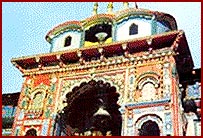
 |
| Visa: Documentation::: Emigration :: Legalization :: News :: Distance Chart : Holidays Home :: Profile :: Contact :: Email |
|
|
Chardham Tour |
|
Badrinath : ABODE OF LORD VISHNU
Tourist Points:
Almora,
Chamoli,Dhanaulti,
Kausani,
Mussoorie,
Nainital
& Ranikhet.
Wild
Life :
Corbett
National Park,
Rajaji
National Park,
Nanda Devi
National Park, Govind
Wildlife
Sanctuary &
National
Park.
Pilgrimage:
Haridwar,Rishikesh,Yamunotri,Gangotri,Kedarnath,Badrinath
and Hemkund Saheb.
Nature Lovers:
Valley of Flowers.
Adventures Seekers:
Skiing & Auli
, Water
Sports and
Trekking.
BADRINATH
 Guarded on either side by the two mountain peak Nar & Narain ,
Badrinath is the holiest of the four main shrines situated on the right bank
of river Alaknanda.Also known as Vishal Badri the largest among the five
Badris, it is revered by all as the apt tribute to Lord Vishnu. So holy is the
shrine that if forms one of the four prominent places of Hindu worship. The
epic Mahabharat, it is believed, was composed in the Vyas and Ganesh Caves
close by. The Vishnu Ganga which later becomes the Alaknanda flows below the
temple. This revered spot was once carpeted with wild berries which gave it
the name �Badri Van� meaning �forest of berries�. The temple opens
every year in the month of April-May & closes for winters in November.
Guarded on either side by the two mountain peak Nar & Narain ,
Badrinath is the holiest of the four main shrines situated on the right bank
of river Alaknanda.Also known as Vishal Badri the largest among the five
Badris, it is revered by all as the apt tribute to Lord Vishnu. So holy is the
shrine that if forms one of the four prominent places of Hindu worship. The
epic Mahabharat, it is believed, was composed in the Vyas and Ganesh Caves
close by. The Vishnu Ganga which later becomes the Alaknanda flows below the
temple. This revered spot was once carpeted with wild berries which gave it
the name �Badri Van� meaning �forest of berries�. The temple opens
every year in the month of April-May & closes for winters in November.
Badrinath�s four subsidiary Badris include Bhavishya Badri, Yogdhyan Badri, Bridha Badri & Adi Badri.
Sight Seeing: Badrinath Temple: This temple is built in the form of a cone with a small cupola of a gilt bull and spire- dedicated to Lord Vishu. The temple prior to Vedic age and the original temple is believed to be built by king Pururava and the icon of lord carved by Vishwakarma, the creator of gods.
The temple is divided into three parts- the �Garbha Griha� or sanctum sanctorum, the �Darshan Mandap� where the rituals are conducted and the �Sabha Mandap� where devotees assemble.
The opening day of the temple is decided with a brief ceremony on the auspicious day of Basant Panchmi, which normally falls during last week or 1st week of May. Special significance is attached to the akhand jyoti darshan on the opening day. The day of closing falls during the second week of November, which is finalised on the day of Dussehra.
Tapt Kund: It is the natural thermal springs on the bank of river Alaknanda, where it is customary to bath before entering the Badrinath temple. The water of the kund is believed to have medicinal properties.
Neelkanth: It is popularly known as Garhwal Queen. It is a shining pyramid of white crystals, which are ever ready to change their colour and hue. Reflecting the first glow of dawn into the valley and glittering like a golden temple, Neelkanth embodies all the divinity of this divine land.
Charanpaduk: 3 km away is a beautiful meadow carpeted with wild flowers in the summer. Here is a boulder bearing the footprints of Lord Vishnu. It is said that when Lord Vishnu descended from Vaikunth ( the heavenly abode of Lord Vishnu) he stepped on this boulder.
Brahma Kapal: The Brahma Kapal, on the bank of the Alaknanda, is a flat platform a few yards north of the temple. Legend has the that when Shiva chopped of the fifth head of Brahma, it got struck to his trident.Lastly with the blessing of Lord Vishnu at Badrivan, the head of Brahma fell down from the trident at this place and hence the name Brahma-Kapal.
Shesnetre: On the opposite bank of the river Alaknanda, in the lap of nar Parvat, there are two small seasonal lakes. Between these lakes is a boulder having an impression of the legendary snake, Sheshnag. The formation of eye on the boulder is natural.
Panch Dharas & Panch Shilas: The Panch Dharas( five streams) which are famous in Badripuri as Prahlasd, Kurma, Bhrigu, Urvasi and Indra dhara.
HEMKUND SAHIB: Discovered by Sikh Havildar Sohan Singh in 1930, was identified with the one referred to by Guru Govind Singh- the tenth Guru of the sikh faith. The place is revered both by Hindus and Sikhs, as well as for people from other faiths it is an important pilgrimage. Encircled by seven snow clad peaks and their associated glaciers, it reflects it surroundings enchantingly on its crystal clear waters. The glaciers from Hathi Parvat & Sapt Rishi Peaks feed the lake and small stream called Himganga flows out to this lake.
According to the beliefs � Lakshman, the younger brother of Ram, meditated by the lake and regained his health after being severely wounded by Meghnath, son the demon Ravana, during the battle.
There is a Sikh Gurudwara and a Lakshman temple built on the bank of the lake.
The waters of Lakshman Ganga(Hem Ganga) coming from Hemkund, in many moods is a source of constant delight to the trekker. The best time to visit is mid July to mid August.
Excursions routes from Hemkund Sahib can be to Valley of Flowers, Kedarnath, Badrinath, Chamoli, Joshimath, Nandprayag, Karnaprayag, Rudraprayag, Srinagar, Deoprayag and Auli.
Copyright � 2002, Royaleeindiavisa.com Site Developed by EON Solutions